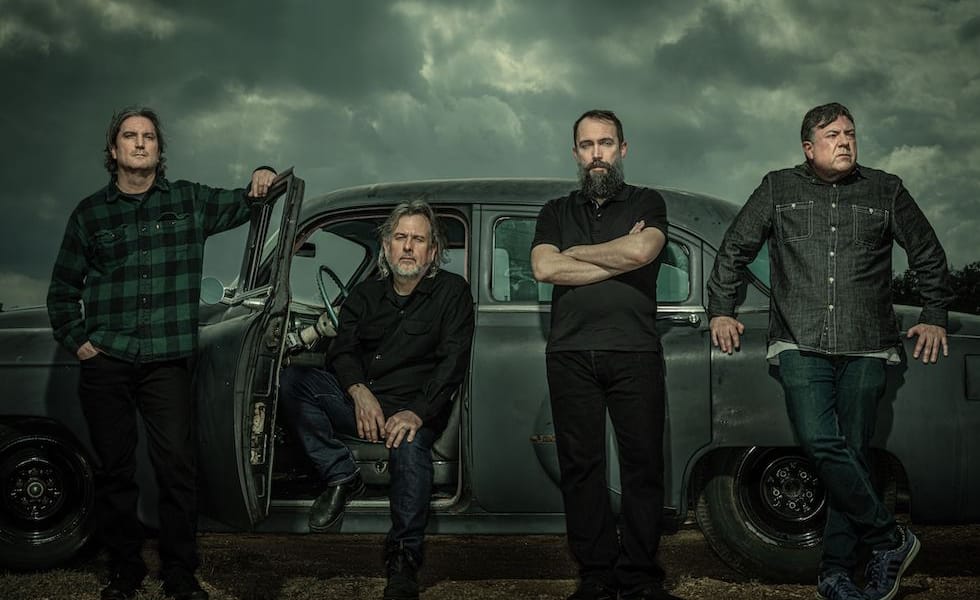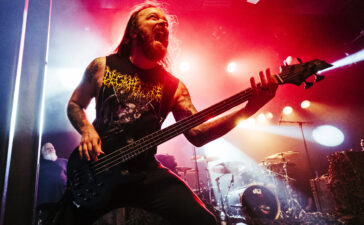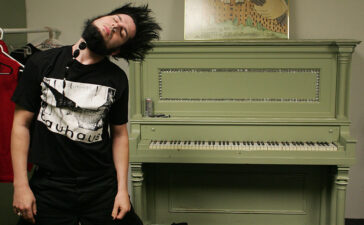You’re travelling through another dimension, a dimension not only of sight and sound but of groove based-rock. A journey into a wondrous land whose boundaries are that of imagination. That’s the signpost up ahead – your next stop, Sunrise on Slaughter Beach, the brand new, and thirteenth, album from Clutch.
Considering the twelve other album studio sessions, it’s rare that anything could take Clutch by surprise, but with ‘Slaughter Beach’, things went differently – in the band’s words, they got “weird.” There are points, such as ‘Red Alert (Boss Metal Zone)’ and ‘Mercy Brown’, that anchor the album firmly in the universe of Clutch, but other moments like ‘Jackhammer Our Names’ take the listener well and truly into uncharted quadrants of it.
It may have been a surprise, but Sunrise On Slaughter Beach wasn’t an accident. Experimenting for the first time with vibraphones, theremin, and backing vocals (provided by Deborah Bond and Frenchie Davis), Clutch courted the weirdness. As BLUNT would learn speaking with drummer JP, aka Jean Paul Gaster, it wasn’t long before the band realised that was the right decision.
There’s one comment that I really want to hone in on. You mentioned that this came out as a different album, when you sort of stepped back and caught your breath from it all. What did you notice was different?
When we began this album it was, for lack of a better word, a party record. I wanted it to be upbeat, and I wanted it to be fun; I wanted it to be fast, maybe something that was a little bit like Earth Rocker. As the writing process went along, I started to realise, “That’s not at all what we have.” I think it was when we were actually recording the record, is when I fully understood, this album is really very different than anything we had envisioned, and probably pretty different than the records that have come before it. I think it’s a darker record than I thought we were going to make.
Part of that I think has to do with the fact that we did not have the opportunity to play these ideas live. So we went into the studio and there was sort of a lot of gray areas. How are we going to approach this idea? And what was I going to play? I wasn’t really sure. Usually, we have this idea that we put on stage, at least a few times before we get into the studio, and that didn’t happen this time. That lent this record its unique vibe.
Do you think that you would’ve had a chance to play these songs and you maybe would’ve gone, “Oh, these are darker, this is downbeat, let’s party it up, let’s add some party?”
I think that probably would’ve happened, I think you’re right. I had not actually looked at it like that. If we had taken those ideas out live, we might have made different choices when we actually got into the studio. I think that’s a very good observation.
The album art is something I rarely ask about, because more often than not it’s an afterthought. But I wanted to talk about the artwork on this one, it’s incredibly striking. Is there a story behind that visual image of the record?
Yeah, there is. The artist that we ended up using was a Swiss illustrator, actually. Neil found him. He usually works with artists to bring some ideas to life. We wanted to do something that wasn’t quite so graphic as the previous records, Psychic Warfare, especially. The image of the, I don’t even know what you call that guy, the sea guy or whatever he is, he is on top of a horseshoe crab.
It’s a wild-looking beast. I can remember going to the beach as a kid and going through the waves, and just getting scared to death from kicking one of these things. And they’re totally harmless, but they look really prehistoric, they’re the most gnarly-looking things. For us growing up on the East Coast of North America, it’s a pretty iconic image. And to have that guy riding a horseshoe crab is kind of wild.
One of the takeaways that I got from this album was just how cinematic it was, how visual of an experience it really was. A starless kind of swamping vista. Even literally mountains of bone, or skeletons on Mars, there are a lot of visual queues with this album.
Neil was drawn to those things, those songs that were maybe a little bit more cinematic, not quite so in your face. But I also think a lot of it has to do also with our producer, Tom Dalgety. We didn’t know him before we went into this record, this is the first time we’d worked with him. He’s a younger guy, at least younger than we are, we’re 50. And I think one of the cool things that caught my attention about Tom’s work was that there’s not a style, or a sound. He’s worked with bands like Opeth, Ghost, The Pixies, people who are all over the map. I think he’s really good at just coming into a band’s practice and listening to ideas, and just picking things that he likes. He was attracted to some of these things that Neil had been singing on, and I think that led the record in that direction as well.
It’s full of peaks and troughs but I have to point out the last track, ‘Jackhammer Our Names’. In my humble opinion, that’s one of the greatest songs you’ve ever written. You’re cautiously listening to it. You’re like, “Where’s this going?” And it ends with a complete gut punch. It’s haunting. What are we meant to be taking away from that ending?
I agree with you that it is haunting. It’s sort of got a soundtrack feel to it as well. For me, the interesting thing about that song is that it wasn’t even really an idea. It was probably one of the most loose things that we’d ever recorded as a band. I can remember playing the drum track, and not really being sure where it was going, very much relying on Tom for direction. Tom had a vision for what this song was going to be.
And I can remember going into the control room and listening back to it, and kind of scratching my head – “Really, that’s what this is?” And Tom’s like, “Yep, that’s what this is.” It didn’t take long, really, just over the course of a few hours for this thing to go from this kind of nebulous idea to this really powerful gut punch, as you say. It really happened in the studio. And again, I think that’s kind of what makes this record so special. There really was a lot of studio magic that probably wouldn’t have happened had we been able to get out there and play these songs live.
It was a great experience. It was probably the most fun I’ve had in the studio in a long time, or in a few records, at least.






